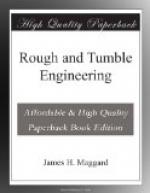While it is not my intention to encourage the foolish habit of pulling engines, to see which is the best puller, should you get into this kind of a test, you will show the other fellow a trick by dropping the exhaust nozzle off entirely, and no one need know it. Your engine will not appear to be making any effort, either, in making the pull. Many a test has been won more through the shrewdness of the operator than the superiority of the engine.
The knowing of this little trick may also help you out of a bad hole some time when you want a little extra power. And this brings us to the point to which I want you to pay special attention. The majority of engineers, when they want a little extra power, give the safety valve a twist.
Now, I have already told you to carry a good head of steam, anywhere from 100 to 120 pounds of steam is good pressure and is plenty, and if you have your valve set to blow off at 115, let it be there; and don’t screw it down every time you want more power, for if you do you will soon have it up to I25, and should you want more steam at some other time you will find yourself screwing it down again, and what was really intended for a safety valve loses all its virtue as a safety, as far as you and those around you are concerned. If you know you have a good boiler you are safe in setting it at I25 pounds, provided you are determined to not set it up to any higher pressure. But my advice to you is that if your engine won’t do the work required of it at 115 pounds, you had best do what you can with it until you can get a larger one.
A safety valve is exactly what its name implies, and there should be a heavy penalty for anyone taking that power away from it.
If you refuse to set your safety down at any time, it does not imply that you are afraid of your boiler, but rather you understand your business and realize your responsibility.
I stated before what you should do with the safety valve in starting a new engine. You should also attend to this part of it every few days. See that it does not become slow to work. You should note the pressure every time it blows off; you know where it ought to blow off, so don’t allow it to stick or hold the steam beyond this pressure. If you are careful about this, there is no danger about it sticking some time when you don’t happen to be watching the gauge. The steam gauge will tell you when the pop ought to blow off, and you want to see that it does it.




